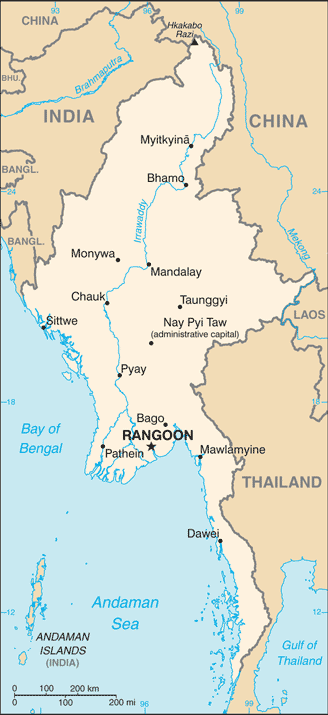We departed San Diego airport bound for Los Angeles at 6:00pm, a short twenty-two-minute flight. Our next flight left from Los Angeles at 11:55pm arriving in Hong Kong at 5:45am, nearly 15 hours later. From Hong Kong we departed at 8:00am bound for Bangkok, Thailand, a three-hour flight. Finally, from Bangkok we boarded our final flight to Mandalay, Myanmar at noon, arriving nearly two hours later. It was an exhausting trip but we made it safe and sound with no delays or incidents.
Myanmar is located on the Bay of Bengal and the Andaman Sea. It borders India and Bangladesh on the north and west, China, Laos and Thailand on the east. King Anawrahta formed the country in the 11th-century, with Bagan as its capital. The empire collapsed with the invasion of the Mongols 200 years later. King Alaungpaya, on the location of the small town named Dagon, founded Yangon (later Anglicized to Rangoon) in 1755. Various ethnic Burmese and ethnic minorities or kingdoms occupied the present borders through the 19th Century. From 1824 to 1886 Britain conquered Burma and incorporated it into its Indian Empire. The country was ruled by the British from 1852 until 1942 when the Japanese occupied the area until 1945. Allies retook the city in 1945 but this would be short lived. On January 4, 1948 the country regained independence from the British Commonwealth. General Ne Win, a military ruler and then a self-appointed president, was an isolationist ruler of the country from 1962 until 1988. During this time the country was isolated from the outside world. In 1988 he resigned due to extreme civil unrest. During his rule the infrastructure deteriorated through poor management (corruption) and population growth.
In 2011 president Thein Sein came into office and began political and economic reforms that lead to the opening of this long isolated country. The reforms included the release of hundreds of political prisoners, a cease-fire with several of the country’s ethnic armed groups, legal reforms and the gradual reduction of restrictions on the freedom of the press. On March 30, 2016 Burma’s first credibly elected civilian government, after more than five decades of military dictatorship, was sworn into office. Some of the government were still military officers.
Myanmar is slightly smaller in size than Texas but has a population of about 57 million inhabitants. Rangoon is the largest city with a population estimated at 7 million, 86% of which are Buddhist. Under British rule the city was laid out in a grid pattern and by 1900 beautiful colonial buildings and parks filled the city. It was said that the city was on par with London and was known as the garden city of the east. Unfortunately, in 2008 much of the city was heavily damaged by cyclone Nargis, which caused $800 million in damage and 138,000 people were left dead. Today these old colonial buildings are being restored and many of the great parks and lakes remain.
Burmese is the primary language, with English being the preferred second language to the educated. The country’s main economies include agriculture, rice, sesame, peanuts, cotton, lima beans, chick peas, wood–like teak, copper, tin, tungsten, iron, cement, construction materials, pharmaceuticals, fertilizer, oil, natural gas, garments, jade, ruby, sapphire, emeralds and amethyst.
Throughout its history Myanmar has experienced waves of immigrants which traveled southward along the Ayeyarwady, Chindwin, Salween and Mekong rivers. These diverse ethnic groups came primarily from the Central Asian Plateau (modern day Tibet and China) and are reflected in the wide-ranging ethnic assortment found in Rangoon today. 86% of the local people are Buddhist, 5% Christian, 4% Muslim and there are 56 Jews today.
The local currency is the Myanmar kyat (MMK) pronounced like CHAT and the current exchange rate is approximately 1,350 kyats to the US dollar.
The living standards are very low in Burma and it remains one of the poorest countries in Asia. Approximately 26% of the residents live in poverty. The isolationist policies of the past have left the country with a poor infrastructure, endemic corruption, underdeveloped human resources and inadequate access to capital. This in combination with an antiquated banking and revenue collection system will take a major commitment to reverse.

